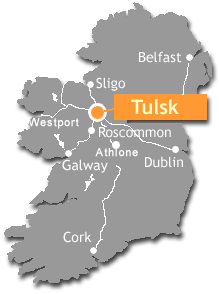The site of Rath Mór, the 'Big Fort', within the complex of monuments at Rathcroghan represents a very strong connection between the ritual sites of the Iron Age landscape and settlement practices of medieval Rathcroghan. The name was first recorded by O'Donovan in 1837 as a fine example of a raised ringfort and one of the few definite high-status medieval settlement sites on the complex.
 |
View of Rathmore raised ringfort from the north. Note the entranceway on the left. (Courtesy of the National Monuments Service)
|
As it is located adjacent to a crossroads it would have seen significant traffic during its period of habitation, which may have provided some basis in its siting. The monument itself is an oval-shaped raised ringfort with, what seems to be, a revetment of drystone walling set into the side of the mound. The ditch surrounding the mound remains up to 8.5m wide and 1.1m deep, with bedrock exposed in places. The entrance is located south east of the monument and is served by a broad, still cobbled ramp, approximately 4m wide across the ditch. The summit is served by a penannular-shaped bank measuring 27m in diameter E/W and 30.4m N/S. However, including the extents of the centre of the summit the site measures to approximately 16m N/S. The height and diameter of the monument today indicate the impressive nature of this ringfort during it's use.
 |
16th-century feasting, from John Derricke The Image of Irelande (1581)
|
Rathmore is one of a great number of large, possibly high-status, ringforts that exist on the complex at Rathcroghan. This Bronze and Iron Age ritual landscape provides the evidence that it was later supplemented by great dwellings and settlement sites. It is through the interpretation of this evidence that something of the interactions of successive generations sought to have with Rathcroghan can begin to be understood including what they believed this landscape symbolised for their community. Daniel Curley






No comments:
Post a Comment